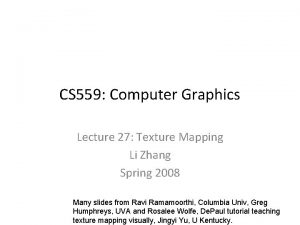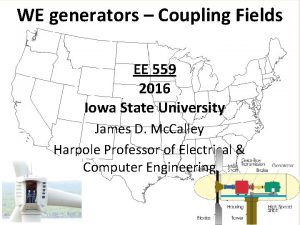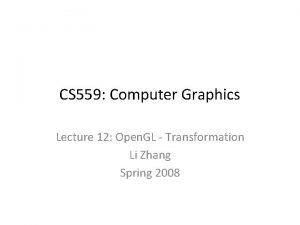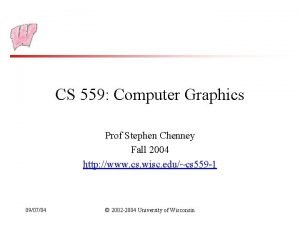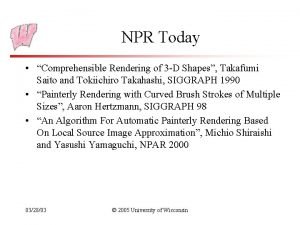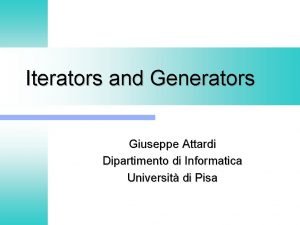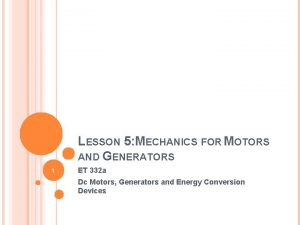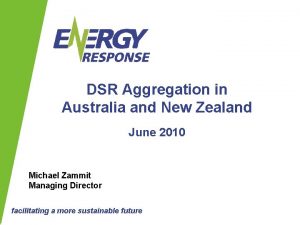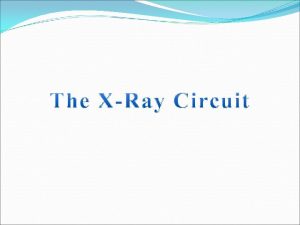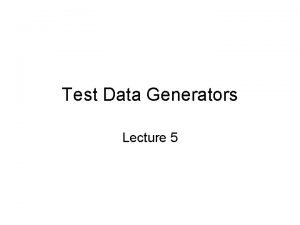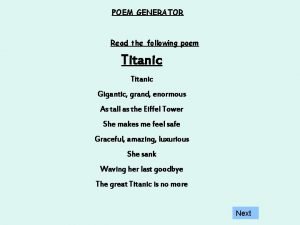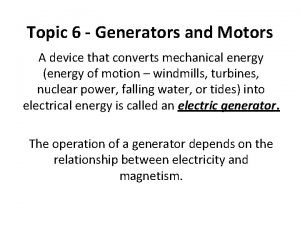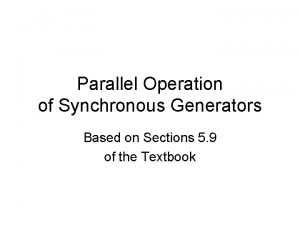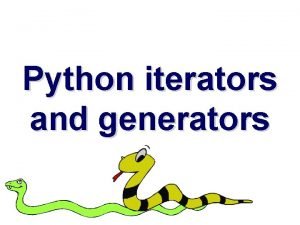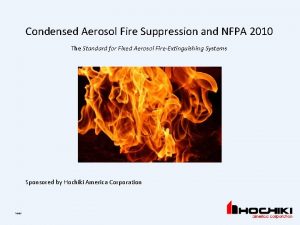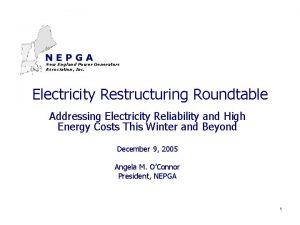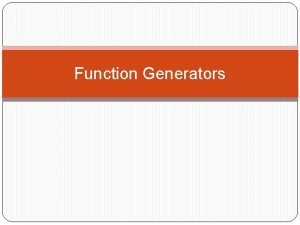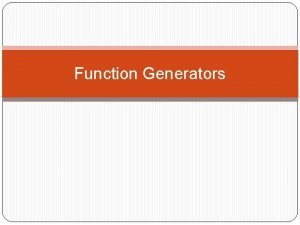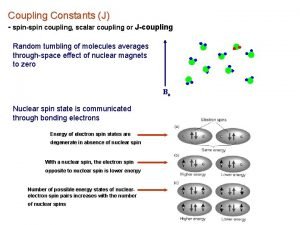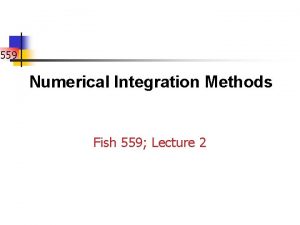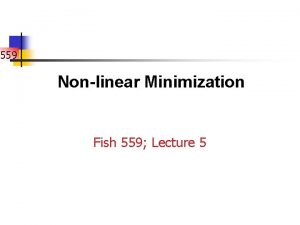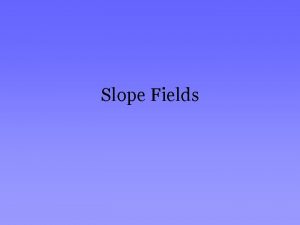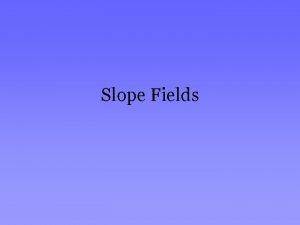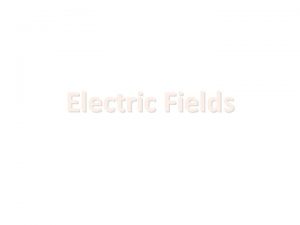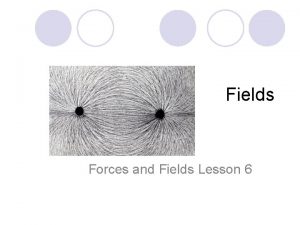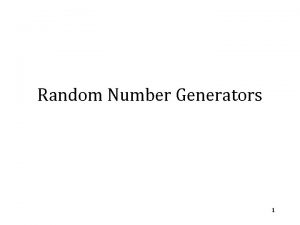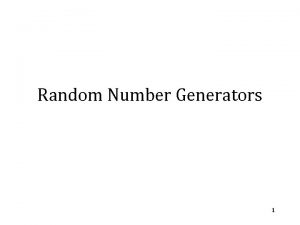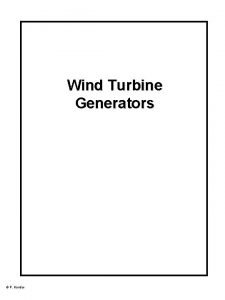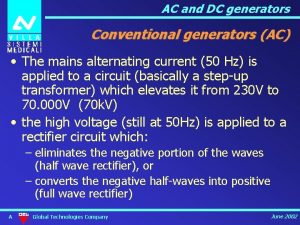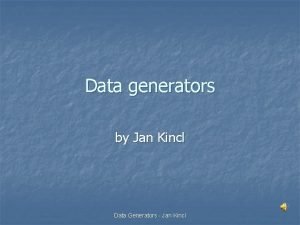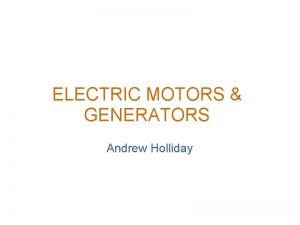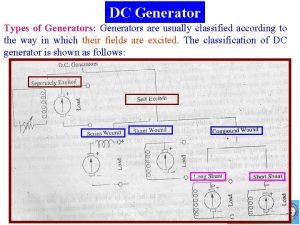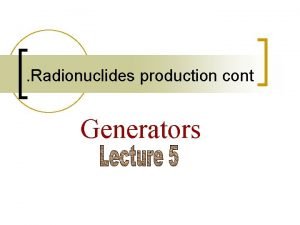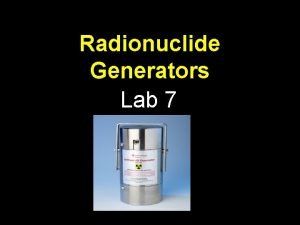WE generators Coupling Fields EE 559 2016 Iowa























- Slides: 23

WE generators – Coupling Fields EE 559 2016 Iowa State University James D. Mc. Calley Harpole Professor of Electrical & Computer Engineering

Torque production Let’s devise a way so that a similar rotating magnetic field is produced by the windings on the rotor, such that it rotates at the same speed as that from the stator. Thus, we now have two rotating magnetic fields. The two rotating magnetic fields, that from the rotor and the composite field from the armature, are “locked in, ” and as long as they rotate in synchronism, a torque (Torque=P/ωm=Force×radius, where Force is tangential to the rotor surface), is developed. This torque is identical to that which would be developed if two magnetic bars were fixed on the same pivot as shown on the next slide.

Torque production In the case of generator operation, we can think of bar A (the rotor field) as pushing bar B (the armature field), as in Fig. a. In the case of motor operation, we can think of bar B (the armature field) as pulling bar A (the rotor field), as in Fig. 11 b. To compute the torque, we must make use of coupling fields and coenergy, according to:

Torque production One can make conceptual use of a version of the Lorentz Force Law, below, in computing torque exerted on a current -carrying conductor in the presence of a magnetic field. However, most electromechanical energy-conversion devices contain magnetic material; in these systems, forces of the B-field act magnetically on the magnetic material, and also on any current-carrying conductors. So the above relation is not enough for us to compute force. Instead, we turn to an energy method, which makes use of The above two relations will allow us to express torque via energy relations.

Coupling fields In electromechanical systems, we have an electrical system, a mechanical system, and a coupling field. We assume in our work that the coupling field is magnetic. Most of the coupling field energy is stored in airgap because it has very large “resistance” (reluctance) to the flux. Coupling field Electrical system Mechanical system Example of an elementary translational-motion electromechanical system with one electrical input, one mechanical input, and one coupling field. P. Krause, O. Wasynczuk, & S. Sudhoff, “Analysis of Electric Machinery, ” IEEE Press, 1995.

Coupling fields Coupling field Mechanical system Coupling field Electrical system Example of an elementary rotational-motion electromechanical system with one electrical input, one mechanical input, and one coupling field. A. Fitzgerald, C. Kingsley, and A. Kusko, “Electric Machinery, 3 rd edition, 1971

Coupling fields Mechanical system is the rotational motion of the rotor. Coupling field is in the flux path of the iron path/air gap Electrical systems are the two coils. Example of an elementary rotational-motion electromechanical system with two electrical inputs, one mechanical input, and one coupling field. P. Krause, O. Wasynczuk, & S. Sudhoff, “Analysis of Electric Machinery, ” IEEE Press, 1995.

Coupling fields: torque The importance of the coupling field is that this is where the energy conversion takes place. If losses in the coupling field (eddy current, hysteresis) are neglected or assumed to be modeled external to the coupling field, then Energy stored in the coupling field = Energy transferred to the coupling field by the electrical system + Energy transferred to the coupling field by the mechanical system OR In differential form, The last equation enables computation of torque. We investigate d. Wm and d. We next. We consider a rotational system with just 1 electrical input and 1 mechanical input.

Coupling fields: torque Generalization of systems with 1 electrical input, 1 mechanical input, and 1 coupling field. This is neglected, or it is represented within the model of the electrical or the mechanical system. A. Fitzgerald, C. Kingsley, and A. Kusko, “Electric Machinery, 3 rd edition, 1971

Coupling fields: torque From previous slide, we observe the electrical terminals at the coupling field receive current i with voltage e. Thus power is ei and the total energy supplied by the electrical source is: In electromagnetic systems, the coupling element is a machine winding, and e will be an induced voltage according to Faraday’s Law: Therefore: For the following development, see (a) P. Krause, O. Wasynczuk, & S. Sudhoff, “Analysis of Electric Machinery, ” IEEE Press, 1995; (b) A. Fitzgerald, C. Kingsley, and A. Kusko, “Electric Machinery, 3 rd edition, 1971; (c) J. Meisel, “Principles of electromechanical-energy conversion, ” Mc. Graw-Hill, 1966.

Coupling fields: torque The mechanical torque Tm and the electromagnetic torque Te are assumed positive in the same rotational direction. We neglect torque due to shaft twist. J: moment of inertia D: damping Then the total energy supplied by the mechanical source is This equation is the rotational analogue to the one for linear motion, which is Term 1 on RHS is stored inertial energy; Term 2 is losses. Only term 3 is energy transferred to coupling field. So…

Coupling fields: torque Substituting expressions (b) and (c) into (a) results in Solving for the torque term results in: (*) Assume independent variables of our system are i, θ. Then: Taking the total differential Substitute these last equations into (*)…

Coupling fields: torque Gather like terms in di and dθ: Equate coefficients: The first expression provides a way to compute torque: (T 1) 13

Coupling fields: torque Define co-energy: Recalling that independent variables of our system are i, θ: Solve for the last term on the right: Substitute into (T 1): (T 1) 0 (T 2) 14

Coupling fields: torque What is co-energy? An expression for which torque computation is convenient (T 2) To better understand co-energy, consider the relation for the coupling field energy: Set the system so that initially, Wf=0 (no stored energy), and fix θ so that no energy can be added to the coupling field via mechanical means, i. e. , Wm=0. Then increase the current to a value ia, establishing a corresponding flux linkage of λa. There is then energy in the coupling field, but only via electrical means, i. e. 15

Coupling fields: torque But recall that: And since Wm=0, this is also the energy of the coupling field: We observe the corresponding area in the λ-i curve in the figure. Recall the definition of co-energy: Since iλ is the area of the (shaded) box, then Wc must be the area below the curve. Wc is therefore given by 16

Coupling fields: torque If the medium is magnetically linear (no saturation), then the λ-i curve is just a diagonal through the iλ shaded box, as shown. In this case, the area above the λ-i is the same as the area below it, and we have: Recall (T 2), which is Therefore, under condition of magnetic linearity, we have: (T 3) 17

Coupling fields: energy Recall from basic physics that the energy stored in a winding of self-inductance Lpp carrying current i is given by: with Lpp in henries and defined by Lpq=λp/Iq=Np. Nq/Rpq for linear medium; Rpq is path reluctance (like resistance). Generalization: For a linear electromagnetic system with J electrical inputs (windings), the total field energy is given by: where Lpq is the winding’s self inductance when p=q and when p≠q, it is the mutual inductance between the two Derivation: Given pp 22 -24 of Krause, Wasynchzuk, and windings. Sudhoff, “Analysis of electric machinery, ” 1995. 18

Example This device consists of two conductors, #1 is on the stator; #2 is on the rotor. The magnetic system is assumed linear. So Wf is given by (with J=2): The self-inductances, given by Lpp=λp/ip, are constant, independent of θ, because the reluctance of the path seen by the winding does not change as the rotor turns. But the mutual inductances are not constant. 19

Example The mutual inductances, given by Lpq=λp/iq, i. e. , the amount of flux seen by winding p due to a current in winding q, are not constant. The extreme conditions of maximum & minimum linkages are given below. θ=0° condition (maximum positive linkage) θ=90° condition (zero linkages) θ=0° condition (maximum negative linkage) The mutual inductance goes from max positive to 0 to max negative to 0 and back to max positive. Thus, L 12, L 21 are: 20

Example θ=0° condition (maximum positive linkage) θ=90° condition (zero linkages) θ=0° condition (maximum negative linkage) The mutual inductance goes from max positive to 0 to max negative to 0 and back to max positive. Thus, L 12, L 21 are: 21

Example Summarizing, we have. L 11, L 22 are constant. Substituting, we obtain Recalling , we obtain 22

Summary The previous procedure can be applied to a three-phase induction machine to obtain an expression for its torque. The effort requires a coordinate transformation which is involved, and so we will not do it. The resulting relation for torque (see Meisel, pp. 321322, and chapter 12) may be used to derive the torque expression for steady-state conditions. We will use this relation in the next set of material. 23
 Red fields to green fields
Red fields to green fields 559 redbook
559 redbook Ee 559
Ee 559 Cs 559
Cs 559 Cs 559
Cs 559 Cs 559 uw madison
Cs 559 uw madison Text generators
Text generators Find generators
Find generators Generators and motors
Generators and motors Ncae results
Ncae results 0677 hofer
0677 hofer Gentrack generators
Gentrack generators X ray circuit diagram
X ray circuit diagram Amperage can be described as
Amperage can be described as Test data generators
Test data generators Personification poem generator
Personification poem generator Generator human design type
Generator human design type Generators and motors
Generators and motors Parallel operation of synchronous generator
Parallel operation of synchronous generator Abb ability smart sensor
Abb ability smart sensor Yield vs return python
Yield vs return python Void volume time empower
Void volume time empower Nfpa 2010 aerosol extinguishing technology
Nfpa 2010 aerosol extinguishing technology New england power generators association
New england power generators association

